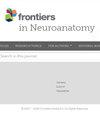妊娠期暴露于VPA会降低新生小鼠腹腔前脑中TH+轴突与钙黄绿素或钙胆蛋白表达细胞之间的并列密度
IF 2.3
4区 医学
Q1 ANATOMY & MORPHOLOGY
引用次数: 0
摘要
妊娠期接触丙戊酸(VPA)是人类自闭症谱系障碍(ASD)的有效啮齿动物模型。众所周知,VPA 治疗会导致特定的交际行为障碍,与人类自闭症的类似改变相吻合。我们实验室之前进行的定量形态计量学研究显示,VPA 治疗小鼠的间脑多巴胺能通路明显减少并出现去筋膜化现象,同时伏隔核(NAc)中的组织多巴胺减少,但尾状突触(CPu)中的组织多巴胺没有减少。在本研究中,使用双重荧光免疫细胞化学和激光共聚焦显微镜评估了酪氨酸羟化酶阳性(TH+)假定轴突末梢的相关分布情况,这些轴突末梢突触前连接到含有钙黄蛋白(CR)或钙巴林蛋白(CB)的靶神经元(母鼠于 ED13.5 日注射 VPA,幼鼠于 PD7 日接受调查)。在 Imaris (Bitplane) 软件的帮助下,对具有代表性的图像堆叠进行了体积分析,以确定突触前(TH+)和突触后(CR+、CB+)结构的空间接近性和丰度。在 VPA 小鼠的 NAc 中,TH/CR 并列减少,而在 OT 中,TH/CB 并列贫乏。在 NAc 中,CR+ 和 CB+ 元素的体积比保持不变,而在 OT 中,CB+ 元素的体积比明显减少;在这里,TH+ 轴突的数量也减少了。在 VTA 和 SN 中,发现 CR 和 CB 与 TH 部分共定位。在暴露于 VPA 的小鼠中,VTA 和 SN 中 CR+(而非 CB+)轴突的数量均有所增加,但 CR+/TH+ 双标记细胞数量的增加并不反映这种上调。在暴露于 VPA 的动物的 OT 中观察到的 CB 总数(而非 CB+ 周细胞数)的减少意味着与传入的 TH+ 轴突的突触接触概率降低,这可能是由于可用的突触表面减少所致。在胚胎发育晚期,对腹侧前脑目标的多巴胺能输入的改变很可能会扰乱神经和突触结构的发育和巩固,从而导致专门参与动机和奖赏的腹侧前脑区域的神经元模式发生持久的变化(这里检测到的是对多巴胺感受性中间神经元的突触输入的减少)。本文章由计算机程序翻译,如有差异,请以英文原文为准。
Gestational VPA exposure reduces the density of juxtapositions between TH+ axons and calretinin or calbindin expressing cells in the ventrobasal forebrain of neonatal mice
Gestational exposure to valproic acid (VPA) is a valid rodent model of human autism spectrum disorder (ASD). VPA treatment is known to bring about specific behavioral deficits of sociability, matching similar alterations in human autism. Previous quantitative morphometric studies from our laboratory showed a marked reduction and defasciculation of the mesotelencephalic dopaminergic pathway of VPA treated mice, along with a decrease in tissue dopamine in the nucleus accumbens (NAc), but not in the caudatoputamen (CPu). In the present study, the correlative distribution of tyrosine hydroxylase positive (TH+) putative axon terminals, presynaptic to the target neurons containing calretinin (CR) or calbindin (CB), was assessed using double fluorescent immunocytochemistry and confocal laser microscopy in two dopamine recipient forebrain regions, NAc and olfactory tubercle (OT) of neonatal mice (mothers injected with VPA on ED13.5, pups investigated on PD7). Representative image stacks were volumetrically analyzed for spatial proximity and abundance of presynaptic (TH+) and postsynaptic (CR+, CB+) structures with the help of an Imaris (Bitplane) software. In VPA mice, TH/CR juxtapositions were reduced in the NAc, whereas the TH/CB juxtapositions were impoverished in OT. Volume ratios of CR+ and CB+ elements remained unchanged in NAc, whereas that of CB+ was markedly reduced in OT; here the abundance of TH+ axons was also diminished. CR and CB were found to partially colocalize with TH in the VTA and SN. In VPA exposed mice, the abundance of CR+ (but not CB+) perikarya increased both in VTA and SN, however, this upregulation was not mirrored by an increase of the number of CR+/TH+ double labeled cells. The observed reduction of total CB (but not of CB+ perikarya) in the OT of VPA exposed animals signifies a diminished probability of synaptic contacts with afferent TH+ axons, presumably by reducing the available synaptic surface. Altered dopaminergic input to ventrobasal forebrain targets during late embryonic development will likely perturb the development and consolidation of neural and synaptic architecture, resulting in lasting changes of the neuronal patterning (detected here as reduced synaptic input to dopaminoceptive interneurons) in ventrobasal forebrain regions specifically involved in motivation and reward.
求助全文
通过发布文献求助,成功后即可免费获取论文全文。
去求助
来源期刊

Frontiers in Neuroanatomy
ANATOMY & MORPHOLOGY-NEUROSCIENCES
CiteScore
4.70
自引率
3.40%
发文量
122
审稿时长
>12 weeks
期刊介绍:
Frontiers in Neuroanatomy publishes rigorously peer-reviewed research revealing important aspects of the anatomical organization of all nervous systems across all species. Specialty Chief Editor Javier DeFelipe at the Cajal Institute (CSIC) is supported by an outstanding Editorial Board of international experts. This multidisciplinary open-access journal is at the forefront of disseminating and communicating scientific knowledge and impactful discoveries to researchers, academics, clinicians and the public worldwide.
 求助内容:
求助内容: 应助结果提醒方式:
应助结果提醒方式:


